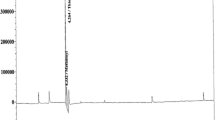Summary
Five different soils varying in physico-chemical properties were used for studying the persistence and degradation of carboxin and oxycarboxin. In one soil only both fungicides were degraded with accumulation of ammonium and nitrite. Under the conditions of forced circulation of air and continuous perfusion, oxycarboxin was found to be more susceptible to degradation than carboxin. Under simulated conditions of rice fields, conversion of carboxin to its sulphoxide and to a non-toxic derivative of oxycarboxin could only be seen in all the soils.
The role of clay, humus and organic matter as protectants of fungicides against degradation indicated that the intermediary compound carboxin sulphoxide was strongly adsorbed probably on organic and inorganic colloids of most of the soils. Organic matter free soils delayed the degradation. Carboxin was rapidly converted to its sulphoxide on three forms of monoionic clays whereas oxycarboxin was transformed to an unidentified derivative.
Similar content being viewed by others
References
Brock, T. D. 1966 Principles of Microbial Ecology. Prentice Hall Inc. Englewood Cliffs, New Jersey, 306 p.
Alexander, M. 1969 Microbial degradation and biological effects of pesticides in soil.In Soil Biology, Reviews of Research, Natl. Resour. Res., Unesco.9, 209–240.
Woodcock, D. 1971 Metabolism of fungicides and nemoticides in Soil,In Soil Biochemistry. Eds. A. D. McLaren and J. Skujins, V. 2, Marcel Dekker, Inc., 337–357.
Tahori, A. S. 1972 Fate of pesticides in environment. Pesticide Chemistry, Gordon and Breach Science Publishers.
McClure, G. W. 1974 Degradation of anilide herbicides by prophamadapted microorganisms. Weed Sci.22, 323–329.
Munnecke, D. M. and Hsieh, D. P. H. 1976 Pathways of microbial metabolism of parathion. Appl. Environm. Microbiol.31, 63–69.
Von Schmeling, B. and Kulka, M. 1966 Systemic fungicidal activity of 1,4-oxathiin derivatives. Science152, 659–660.
Sethunathan, N. 1973 Organic matter and parathion degradation in flooded soil. Soil Biol. Biochem.5, 641–644.
Grover, R. 1974 Adsorption and desorption of urea herbicides on soils. Can. J. Soil Sci.55, 127–135.
Lane, J. R. 1970 Colorimetric microdetermination of vitavax (5,6-dihydro-2-methyl-1,4-oxathiin-3-carboxanilide) residues in crops. J. Agric. Food Chem.18, 409–412.
Saltzman, S., Yaron, B. and Mingengrin, U. 1974 The surface catalyzed hydrolysis of parathion on kaolinite. Soil Sci. Soc. Am. Proc.38, 231–234.
Bremner, J. M. 1965 Inorganic forms of nitrogen.In Methods of Soil Analysis. Ed. C. A. Black. Agronomy series No.9, Part 2, Am. Soc. Agron. Madison, Wisc. 1179–1232.
Bray, H. G. and Thorpe, W. V. 1954. Analysis of phenolic compounds of interest in metabolism. Meth. Biochem. Anal.1, 27–52.
Toennies, G. and Kolb, J. J. 1951 Techniques and reagents for paper chromatography. Analyt. Chem.37, 854.
Helweg, A. 1973 Persistence of benomyl in different soil types and microbial breakdown of the fungicide in soil and agar culture. Saertryk Af Tidsskrift Planteavl.77, 375–384.
Chin, W. T., Stone, G. M. and Smith, A. E. 1970 Degradation of carboxin (Vitavax) in water and soil. J. Agric. Food Chem.18, 731–732.
Edgington, L. V. and Corks, C. 1967 Biological decomposition of an oxathiin fungicide. Phytopathology57, 810.
Balasubramanya, R. H. 1978 Microbial metabolism and behaviour in soil of two carboxanilide fungicides. Ph.D. Thesis, submitted to U.A.S., Bangalore-65, India.
Katan, J., Fuhremann, T. W. and Lichtenstein, E. P. 1976 Binding of (14C) parathion in soil: A reassessment of pesticide persistence. Science193, 891–894.
Author information
Authors and Affiliations
Additional information
Part of Ph.D. thesis submitted to UAS, Bangalore-65.
Rights and permissions
About this article
Cite this article
Balasubramanya, R.H., Patil, R.B. Degradation of carboxin and oxycarboxin in different soils. Plant Soil 57, 195–201 (1980). https://doi.org/10.1007/BF02211679
Received:
Revised:
Issue Date:
DOI: https://doi.org/10.1007/BF02211679




